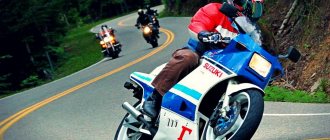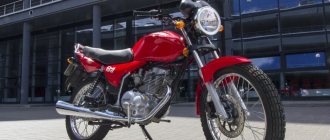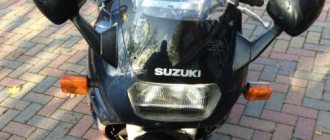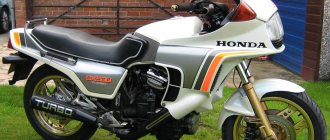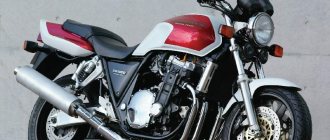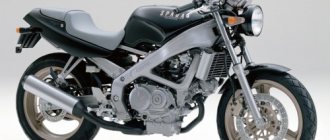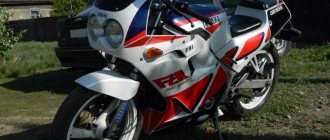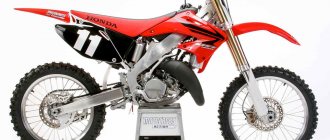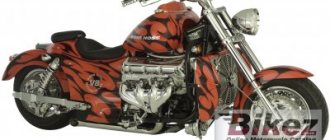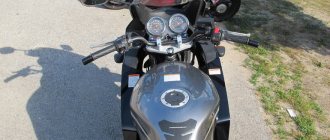- motorcycle model, Kawasaki brand,
The Kawasaki GPX600R sports motorcycle model came to the market in 1988 as a successor to the Kawasaki GPZ600R model. In the North American market, both models were sold under the name Kawasaki Ninja 600R and were not divided into GPZ and GPX.
Compared to the Kawasaki GPZ600R, the new version of the Kawasaki GPX600R receives a number of technical differences:
Engine. I got lighter connecting rods and pistons, increased the diameter of the intake ports, and increased the compression ratio from 11.0 to 11.7.
Maximum power increased to 85 hp.
Ignition. The model receives a more advanced digital ignition.
Exhaust. The model receives a new 4-into-2 exhaust system.
Brakes. 1-piston front and rear brakes are replaced with more powerful 2-piston ones. Wheels. The front wheel comes with a slightly reduced profile (80 mm instead of 90 mm). Pendants. The model gets a thicker fork (38 mm instead of 37 mm) and an ESCS electric anti-dive system instead of a mechanical AVDS.
The Kawasaki GPX600R was an export model and was only sold in the European and North American markets. A 400 cc version of the Kawasaki GPX400R was offered for the domestic Japanese market. It is worth noting that from the very beginning, domestic modifications of the GPZ were equipped with an aluminum frame (only the GPX received a steel frame), while the GPZ600 and GPX600 came with a steel frame (the only exception is the American version of the Ninja 600RX of 1987).
The Kawasaki GPX 600 model existed on the market until 1997 inclusive, after which it finally left the assembly line, giving way to the Kawasaki ZZ-R600 and Kawasaki ZX-6R models.
Dimensions and weight
The length of the motorcycle is 2095 millimeters, width – 690 millimeters, height – 1150 millimeters. The wheelbase of this bike is 1425 millimeters, and the seat height is 755 millimeters. The curb weight of the motorcycle reaches 208 kilograms, which is an average for the class. The volume of the gas tank is 18 liters.
Video
Sports touring motorcycle Kawasaki GPX 600
was produced from 1985 to 1989, and due to the advanced age of most copies, it is not so easy to find a living copy of this bike on the roads these days. However, old motorcycles, designed by engineers, not marketers, have a huge resource and an amazing reserve of survivability, so sometimes such two-wheeled road veterans are found on sale, and sometimes even in a “living” state. It was the GPX 600, indirectly related to the famous Ninja line, that brought invaluable experience to Kawasaki, which later found its application in the production of the Kawasaki ZZR line of motorcycles. Being a very technologically advanced motorcycle for its time, it was produced in parallel with its older brother - the Kawasaki GPX 750. It is difficult not to recognize it - the same angular design of the 80s, characteristic of the entire GPX series, the same silhouette and the same outlines. However, some of its features are worth dwelling on in more detail.
Without any mind-blowing technical characteristics, the GPX 600 is a strong mid-ranger in this regard. Thus, its in-line four is distinguished by moderate power, but very balanced settings, producing 53 hp. and 53 Nm of torque. This is not so much, comparable to some “four hundred” like the Honda CB400SF, but the GPX wins in torque and, as a result, in acceleration dynamics, not to mention the fact that it accelerates confidently, but very smoothly, without brightness. pronounced dips and pick-ups, which adds comfort. The Kawasaki GPX 600 accelerates from 0 to 100 km/h in 4 seconds, and the top speed of this motorcycle is about 220 km/h. Since this is a sports touring device, and not a radical sports bike for the track, such modest characteristics by the standards of 600 cc “sports” cannot be attributed to its disadvantages. The motorcycle has enough dynamics to feel confident both in city traffic and on the highway, where with one turn of the knob you can easily accelerate from 120-130 to 170-180 km/h, after which, of course, the dynamics begin to sag noticeably. The presence of a passenger, by the way, also does not have the best effect on it, especially with regard to handling. In general, we can say that the Kawasaki GPX 600, equipped with a classic tubular steel frame, handles tolerably, like a “four”, but if the second number sits on the tail, then the rear of the motorcycle begins to noticeably “float” in turns.
In general, this sport-tourist is well suited for long trips on roads of normal quality. For its time, it was, of course, a very technically advanced bike, but it does not lose its relevance even now. Quite spacious and comfortable, the Kawasaki GPX 600 has developed wind protection, thanks to which the desire to lie with your chest on the gas tank arises only at speeds close to the maximum, and although simple, it has good suspension that copes well with minor road irregularities. The 18-liter gas tank is also pleasing, considering the consumption is within 6 liters per hundred with measured driving at 120-140 km/h. These days, finding a Kawasaki GPX 600 in a living condition is not easy, given that this motorcycle was produced for only four years, and its last copies rolled off production lines more than a quarter of a century ago. However, Japanese quality has shown itself here too, and from time to time the GPX 600 can still be seen on the roads. If you can find this bike in good condition, it will become an excellent alternative to the 400 cc and 600 cc Zizers, and, most likely, even for a lower price, and without the sores typical of the mentioned Zizers, such as problems with the gearbox.
Materials: https://motoli.ru/178-kawasaki-gpx-600-gpx600r-zx600c.html
Chassis and brakes
The motorcycle has a steel tubular frame, which is perfect for a representative of the sports bike class. Alloy wheels look interesting: you can immediately see that these are not classics, but they don’t look very much like sports wheels either. The steering wheel of the Kawasaki GPH600 is stylish and comfortable.
The rear suspension is pendulum and has a pneumatic monoshock absorber. Its stroke is 130 millimeters. The front suspension is a 38 mm telescopic fork with an anti-dive function. Its stroke is 140 millimeters. The rear brakes are equipped with a single disc with a diameter of 250 millimeters and a two-piston caliper. The front brakes are represented by two discs, each 270 millimeters, with two-piston calipers.
Examples of finds
Russian Australian Rudolf Kavchik talks about the search for gold in his film. With a license, according to the normal scheme. The scattering of nuggets in the first frames is already impressive. And a 27 kg nugget just gets me off my feet - sell everything, buy a GPX 5000 and go to Australia.
Paul Olsen from Queensland shares his experience of gold prospecting on one of his websites. I started with grains, then reached 6 grams per day, and later - up to 30. Thoughtful work with the device, using a 10-inch coil instead of a 14-inch one bore fruit.
Russian wild gold miners are secretive people and do not talk about their exploits.
Read also: Beach search - which device is best to search the beach with and what can be found in one dig! Move on!
Motorcycle Kawasaki GPX 600R Ninja 1987 review
Technical specifications Kawasaki GPX 600R Ninja 1987
Engine Kawasaki GPX 600R Ninja 1987
Transmission Kawasaki GPX 600R Ninja 1987
Dimensions and weights of Kawasaki GPX 600R Ninja 1987
Chassis and brakes Kawasaki GPX 600R Ninja 1987
Dynamic characteristics of Kawasaki GPX 600R Ninja 1987
Other characteristics of Kawasaki GPX 600R Ninja 1987
Description Kawasaki GPX 600R Ninja 1987
Description of the Kawasaki GPX 600R Ninja 1987 motorcycle is in the queue for publication of the article. Announcement: Today, for almost every new motorcycle that comes into being, marketers strive to carve out their own niche. This one is a road sport, this one is a recreational enduro. But what class should we include a motorcycle that has a little bit of everything? A good bike should have a reliable engine, comfortable ergonomics and simple controls.
Despite the fact that good models of motorcycles have a very respectable price, and the season for their use is relatively short, the motorcycle market is developing rapidly. And if you believe the words of dealers, then some models of recently released motorcycles are selling like hot cakes at the beginning of the season, and the models brought to Russia are clearly not enough to fully satisfy consumer demand.
A motorcycle has long ceased to be an alternative to a car, and the times when this equipment was bought only because there was not enough money for a full-fledged car are forgotten. Nowadays, two-wheelers can be called technological marvels in many cases, and their cost can be compared with that of prestigious cars.
Many people have started buying motorcycles for hobby purposes as riding or even collecting them has become a good pastime for many people. Many motorcycles, for example the Kawasaki GPX 600R Ninja, whose technical characteristics make it possible to call the model a prestigious brand, are in demand among both beginners and experienced motorcyclists.
Currently, it is impossible to purchase a new Kawasaki GPX 600R Ninja motorcycle from the 1987 model year, since their production stopped 29 years ago. At the same time, the Kawasaki GPX 600R Ninja has excellent technical characteristics, so many are eager to purchase, if not a new, then at least a used version.
Motorcycles with an engine capacity of 598 cc. see, appeared as a result of long work of inventors who sought to create a model that was not inferior in characteristics to other versions of the motorcycle. In some cases, these models are not only not inferior, but also ahead of other motorcycles, as they have minimal fuel consumption and other excellent parameters.
Motorcycles with an engine capacity of more than 400 kb. cm, which includes the Kawasaki GPX 600R Ninja - this category of motorcycles simply cannot claim the title of “motorcycle for a beginner.” On the contrary, this is already a serious technique that requires certain control of motorcycle equipment with a smaller engine capacity. Yes, she attracts more attention, she is the most beautiful, fast, interesting and there is a huge selection of models. But as power increases, the weight of the motorcycle inevitably increases. In this class you are unlikely to find motorcycles lighter than 180 kg, unless they are the latest motorcycle models.
Go to the entire range of Kawasaki motorcycles, on this page you can find Kawasaki GPX 600R Ninja motorcycles of other years and information about them
Motorcycles similar in characteristics to the GPX 600R Ninja:
Showing similar motorcycles with a limit of 5 pieces, see all similar to GPX 600R Ninja
Kawasaki GPX 600R Ninja price based on sales advertisements
* Attention! Under the maximum, average and minimum of the Kawasaki GPX 600R Ninja motorcycle on this page, the average cost according to advertisements for sale on the Internet is indicated, without taking into account the year of manufacture, configuration and generation of the motorcycle model.
Sales statistics of Kawasaki GPX 600R Ninja by regions of the Russian Federation (in the form of shares)
- Krasnodar region 6.33%
- Rostov region 8.86%
- Crimea 6.33%
- Kaliningrad region 3.80%
- St. Petersburg 5.06%
- Khanty-Mansi Autonomous Okrug 5.06%
- Voronezh region 5.06%
- Moscow 8.86%
- Bashkortostan 3.80%
Five random motorcycles:
Five random articles about motorcycles:
Java is 60 years old!
Java is sixty! Is this a lot or a little for a motorcycle brand? If compared with the first Czech motorcycle “Laurin and Klement”, which appeared thirty years earlier, JAVA is not so old. But in this case, it is not the date of birth that should be taken into account. Of the more than 2,500 different brands of motorcycles that have ever been produced in the world and included in the “Illustrated Encyclopedia of Motorcycles” (there is one in the West), there are barely a dozen like YAVA, with such a rich history. It began in 1929, when the owner of the arms factory, Frantisek Janeček, presented at the Prague Motor Show his first motorcycle, built under a German license (from the initial syllables of these surnames, as is known, the name JAVA was born). It was a rather expensive and heavy machine weighing 175 kg, equipped with a single-cylinder four-stroke engine with a displacement of 498.7 cm3 and a power of 18 hp. s./13 kW, which did not have commercial success. E.
Java Automatic
With an automatic centrifugal clutch engagement mechanism, the motorcycle has existed for more than half a century. Throughout this time, he has constantly improved. And today, tireless work continues to increase engine power, improve the layout of the car, and increase comfort. Every year hundreds of applications are received by patent offices. In recent years, many designers have been busy developing new types of engines for single-track vehicles. Experimental models with such equipment have already appeared on the roads. If we take into account that the path from experimental samples to serial production sometimes takes a decade, then we can assume that the appearance of radically new machines is not in the near future. Work aimed at making the motorcycle easier to drive is much closer to completion. Relatively recently, the attention of motorcycle industry specialists was drawn to two Javas. The red cars were not much different in appearance from their well-known counterparts. And the layout is the same.
Motorcycles that are waiting. Future newcomers IZH Planet 2 and Jupiter 2
Future newcomers IZH Planet 2 and Jupiter 2 Hundreds of blue IZHs roll off the factory assembly line every day. This motorcycle won't have long to wait either. A few more efforts and the car will come to life. Motorcycle enthusiasts are well aware of the IZH-Planet and IZH-Jupiter motorcycles. Our plant has been producing them since 1961 - 1962. And since that time, work has been continuously going on to improve them. The reliability of cars has increased significantly, and thanks to this, the warranty mileage of motorcycles has increased by 20 percent. Factory designers work not only to eliminate defects identified during operation, but also to improve the model on the assembly line. Our design bureau also prepared new, modernized models of motorcycles, paying special attention to such qualities as reliability and durability. Now the work on creating and testing new machines has been completed. “IZH-Planet-2” and “IZH-Jupiter-2” are ready for launch. How do they differ from their well-known predecessors? First thing is bro.
Owners of IZH Planet Sport
On these latest motorcycles, the rear part of the muffler is raised to improve cross-country ability. Now, in order to remove the axle when dismantling the rear wheel, you have to disconnect the muffler. This can be avoided by inserting the axle from the right side, for which it is enough to halve the thickness of the washer installed under the axle fastening nut. * * *In the magazine “Behind the Wheel” it was reported that instead of the standard relay-regulator IZH-PP2S, which is quite difficult to purchase, you can use a relay from a Moskvich car of the latest models. It’s even more convenient to use a PP380 voltage relay from a Lada car. To install it, you do not need to look for another place, since it is located in the same place as the previous one (this is the advantage). Terminals “15” and “67” of the relay are connected, respectively, to the terminals “+” and “Ш” of the generator (“minus” of the relay is removed to "ground"). V. PALAGIN346421, Novocherkassk, Rostovskoe sho.
Review of the Kawasaki GPZ600R (Ninja 600R) motorcycle
Kawasaki GPZ600R sports motorcycle model
appeared in 1985 and is considered the ancestor of all Kawasaki sports motorcycles in the 600 cm³ class.
On the North American market, the model was called Kawasaki Ninja 600R
. The model was aimed at sales in Europe and North America, so it is extremely rare in Japan. Instead, there was a 400 cc model on the Japanese market - the Kawasaki GPZ400R.
The Kawasaki GPZ 600 R was based on an in-line 4-cylinder liquid-cooled engine with a volume of 592 cm³ and producing 75 hp. power and almost 52 Nm of torque, which at one time was hardly a record figure.
In 1987, the Kawasaki Ninja 600RX
, which exists only for this year and differs from the standard version of the Ninja 600R in its aluminum frame and slightly lighter weight. This modification was not available on the European market.
Among the features of the Kawasaki GPZ600R, it is worth noting the suspension, which at the front is presented in the form of an air fork with an anti-dive system and an air monoshock at the rear with an adjustable rebound characteristic. Despite their archaic nature, compared to more modern suspensions, they were cutting-edge technology at the time of their release.
The braking system is fully disc, with 1-piston calipers and discs with a diameter of 270 mm. The motorcycle was also equipped with narrow 16′ wheels, which was typical for sports motorcycles of the time (modern models use 17′ wheels).
Other important features of the Kawasaki GPZ600R include a 6-speed gearbox, an 18-liter fuel tank and a 217 kg curb weight (the aluminum frame version of the Ninja 600RX weighed 213 kg).
1989 was the last year of production of the model, after which it was finally replaced by the Kawasaki GPX600R, which appeared on the market in 1988. By the way, in the American market there was no division of models into GPZ and GPX - there both models bore the same name Ninja 600R, so to distinguish between the American versions it is recommended to compare the factory designations of the models:
- Kawasaki GPZ600R (Ninja 600R) – ZX600A
. - Kawasaki Ninja 600RX (aluminum frame) – ZX600B
. - Kawasaki GPX600R (Ninja 600R) – ZX600C
.
Content
Brief history of the model
- 1985 – start of production and sales of Kawasaki GPZ600R. The model is available only in the North American market under the name Ninja 600R.
Model
: Kawasaki Ninja 600R (North America).
Factory designation
: ZX600-A1.
- 1986 – no significant changes.
Model
: Kawasaki Ninja 600R (North America).
Factory designation
: ZX600-A2.
- 1987 - Model available in Europe under the name Kawasaki GPZ600R. The appearance of a modification with an aluminum frame (Ninja 600RX), available only on the North American market. Last year of production for the American market.
Model
: Kawasaki GPZ600R (Europe);
Kawasaki Ninja 600R, Kawasaki Ninja 600RX (North America). Factory designation
: ZX600-A3, ZX600-B1.
- 1988 – Kawasaki GPZ600R model is available only in the European market.
Model
: Kawasaki GPZ600R (Europe).
Factory designation
: ZX600-A4.
- 1989 – last year of production.
Model
: Kawasaki GPZ600R (Europe).
Factory designation
: ZX600-A5.
